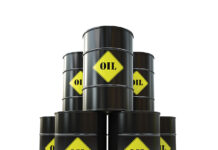
2020 has probably been an annus horribilis for shale oil since the industry first emerged in early 2008. Compared to the previous oil bust in 2015, the main difference in addition to negative WTI prices has been the lack of new capital supporting the sector.
As a result, many players, when not acquired by a competitor, went into bankruptcy, especially on the services side, posing questions around the potential of the rebound in 2021. Oil bankruptcy filings climbed in 2020 to $53.9 billion, four times more than the previous year, according to law firm Haynes and Boone.
Crude exports at their highest in early 2020
The year, however, started very well with stabilized oil prices at around $60 a barrel, with record production and, therefore, of U.S. oil exports. As highlighted in the chart, Q1 20 U.S. shale grade exports were strong, at 2.5 million barrels on average, but decreased to 1.8 million barrels at the lowest in November. For the full year, U.S. shale grade departures increased 11.9% compared to a year ago despite decreased global demand. As of December 2020, we have seen an increase in exports, with departures 7% higher than the November level but 27.5% lower than the December 2019 level, when shale grade exports hit an all-time high. Midland shipments increased by 6.2% m/m and 13.2% y/y to 1,367 kbd, while exports of WTI were down slightly to 464 kbd. Eagle Ford exports rebounded from the lowest level in 28 months of 72 kbd in November, standing at 105 kbd in December.
The key question remains of what can happen in 2021 with oil prices rebounding in the first two months of the year?
Cash is (still) king for investors
With many players in the oil services sector now gone and with fewer fracking fleets, re-starting the industry could take much longer this time than during the last bust. Frac sand, a critical path component in fracking, could be a chokepoint for the industry’s rally in the first part of the year 2021, as fleets compete to stay sanded in a weakened supply chain. Many sand miners collapsed or were underinvested because of low prices. It looks as if supply-chain disruptions will be unavoidable.
Caution is clearly the outcome for 2021 within oil company management. According to a poll of shale oil executives who were asked to provide the WTI price they used for planning their capital expenditures in 2021, the average response was $44 a barrel. But the correlation between investments/production and oil prices could be a little bit different in 2021 due to capital discipline and restraint by oil services.
Cash flow generation is needed to survive, and maybe even more importantly, is what investors are looking for. As a reminder, financial markets haven’t rewarded U.S. shale for its record production growth but rather punished the stocks as cash flows were missing. There are hopes that this time, shale firms will keep their promises to stay disciplined and, according to some oil companies during their Q4 20 earnings releases, they want to convince that they have finally learned their lesson and have a way to win investors back again. Even big players like Chevron mentioned that it could take until the second half of the year or even early 2022 before conditions are right to increase investments in new drilling.
A first step was already made in 2020 in terms of capital discipline, with a reinvestment rate below 100 for the first time ever. Essentially, companies invested less than they generated from operating cash flow. Pioneer, one of the biggest pure shale players, expects $2 billion in free cash flow for 2021 and will, for the first time, start to pay a variable dividend in 2022 in addition to its regular dividend, while Devon Energy followed the same trend.
In terms of shale production, the year ended at 7.44 mbd, down nearly 20% compared to 2019. Going back to 2019 levels looks almost impossible in the next 18 months for the reasons mentioned above, even with oil at $70 a barrel. Stability on average in 2021 vs. 2020 is probably what to expect, but this would already be an increase of 0.5 mbd when comparing December 2021 to December 2020. Only oil prices above $80 a barrel for a couple of months could significantly change the outcome for 2021 as at that price cash flow generation starts to be massive. The other metrics that could determine the size of the ramp-up is natural-gas prices, as the production of dry gas and NGLs account for nearly half of the Texan shale production or nearly a quarter of its revenues.
Texas’ deep freeze to decrease production potentially by 200 kbd
Another uncertainty for 2021 is the recent deep freeze in Texas which has been heavily impacting oil and gas production for several days, with more than 70% of U.S. completion crews no longer active. Across the U.S., more than 4mbd of production have been lost. This comes as bad timing for the Permian Basin, not only because balance sheets look weak and cash flow is missing to survive, but also because many of those wells just fracked deliver much of their oil in the first days after completion.
The key question lies in the impact on the infrastructure, wells and oil equipment for the restart. There is no recent precedent, so it is difficult to know when things will get back to normal and how much well work will be required. One of the examples mentioned by local players is frac sand plants. It could be a challenge to resume operations as rolling power blackouts and gas curtailments could have destroyed equipment as well as causing problems to restart engines. In the field, thawing won’t be easy either (frac iron and water transfer issues will be prevalent), and road conditions could be bad as well. All in all, with nearly a 4mb loss for a couple of days and a slow full restart (3-6 weeks), the winter episode could hit average production in 2021 by 200kbd. Most Pioneer Resources production is back online, and storm damage repairs are “minor in the grand scheme of things,” according to the CFO of the company.
Lower potential in the medium term
In the medium term, more concern arrives with the capacity to keep a sustainable high growth of production on reservoir quality. Even big players look to be playing down medium-term production targets. Exxon recently announced it expects to produce 700kbd in the Permian by 2025, nearly double vs. 2020 but much less than the 1mbd expected.
What we have learned in the past years in this industry is that it is already very difficult to predict what can happen in the next 12 months, so writing about two to four years’ prospects looks a bit like science fiction.
About the author: Alexandre is Senior Commodity Analyst at Kpler, the leading provider of data and analytics in commodity markets. He joined Kpler’s Research Team in 2018, which brings insights to the commodity community by harnessing Kpler’s considerable array of proprietary data. Alexandre leads on crafting research and analysis regarding industry equities as well as shale oil, given his extensive knowledge of the sector. In addition, Alexandre provides industry insight to media outlets like Bloomberg and Forbes and is also a published author of an award-winning book on the shale industry.














